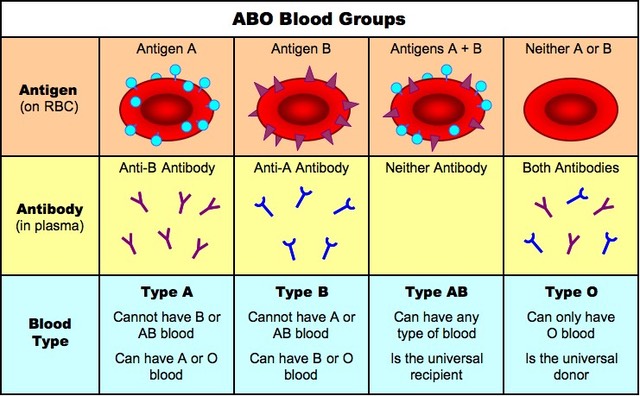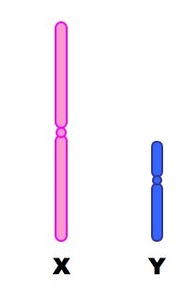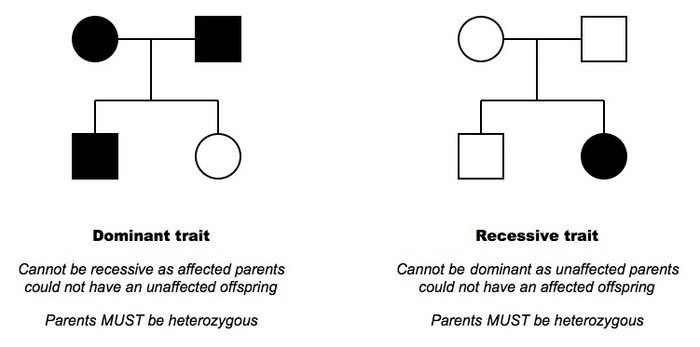4.3.1 Define genotype, phenotype, dominant allele, recessive allele, codominant alleles, locus, homozygous, heterozygous, carrier and test cross
Genotype: The allele combination of an organism
Phenotype: The characteristics of an organism (determined by a combination of genotype and environmental factors)
Dominant Allele: An allele that has the same effect on the phenotype whether it is present in the homozygous or heterozygous state
Recessive Allele: An allele that only has an effect on the phenotype when present in the homozygous state
Codominant Alleles: Pairs of alleles that both affect the phenotype when present in a heterozygote
Locus: The particular position on homologous chromosomes of a gene
Homozygous: Having two identical alleles of a gene
Heterozygous: Having two different alleles of a gene
Carrier: An individual that has one copy of a recessive allele that causes a genetic disease in individuals that are homozygous for this allele
Test Cross: Testing a suspected heterozygote by crossing it with a known homozygous recessive
4.3.2 Determine the genotypes and phenotypes of the offspring of a monohybrid cross using a Punnett grid
A genetic cross is a means of determining the genetic characteristics of potential offspring based on the genetic characteristics of the prospective parents
A monohybrid cross determines the allele combinations of offspring for one particular gene only (HL students may refer to topic 10.2 for dihybrid crosses)

Monohybrid crosses can be calculated according to the following steps:
Step 1: Designate characters to represent the alleles
- Capital letter for dominant allele, lower case letter for recessive allele
Step 2: Write down the genotype and phenotype of the parents
- This is the P generation (parental generation)
Step 3: Write down the genotype of the parental gametes
- These will be haploid as a result of meiotic division
Step 4: Use a Punnett grid to work out the potential gamete combinations
- As fertilisation is random, all combinations have an equal probability
Step 5: Write out the genotype and phenotype ratios of potential offspring
- This is the F1 generation (first filial generation)
- Subsequent generations through interbreeding labeled F2, F3, etc.
Note: The genotypic and phenotypic ratios calculated are only probabilities
4.3.3 State that some genes have more than two alleles (multiple alleles)
Some genes have more than two alleles for a given trait (e.g. the ABO blood group system)
The alleles which are not recessive may either:
- Share codominance (be expressed equally in the phenotype)
- Share incomplete dominance (neither is fully expressed in the phenotype, resulting in blending)
- Demonstrate a dominance order (e.g. allele A > allele B > allele C)
4.3.4 Describe ABO blood groups as an example of codominance and multiple alleles
When assigning alleles for codominance, the convention is to use a common letter to represent dominant and recessive and use superscripts to represent the different codominant alleles
- I stands for immunoglobulin (antigenic protein on blood cells)
- A and B stand for the codominant variants
The ABO gene has three alleles: IA, IB and i
- IA and IB are codominant, wherease i is recessive (no antigenic protein is produced)
- Codominance means that both IA and IB alleles will be expressed within a given phenotype
The genotypes and phenotypes of the ABO blood groups are:

The ABO Blood Group System

4.3.5 Explain how sex chromosomes control gender by referring to the inheritance of X and Y chromosomes in humans
Humans have 23 pairs of chromosomes for a total of 46 (excluding instances of aneuploidy)
The first 22 pairs are autosomes - each chromosome pair possesses the same genes and structural features
The 23rd pair of chromosomes are heterosomes (or sex chromosomes) and determine gender
- Females are XX - they possess two X chromosomes
- Males are XY - they posses one X chromosome and a much shorter Y chromosome
The Y chromosome contains the genes for developing male sex characteristic - hence the father is always responsible for determining gender
- If the male sperm contains the X chromosome the growing embryo will develop into a girl
- If the male sperm contains a Y chromosome the growing embryo will develop into a boy
- In all cases the female egg will contain an X chromosome (as the mother is XX)
Because the X and Y chromosomes are of a different size, they cannot undergo crossing over / recombination during meiosis
This ensures that the gene responsible for gender always remains on the Y chromosome, meaning that there is always ~ 50% chance of a boy or girl
4.3.6 State that some genes are present on the X chromosome and absent from the shorter Y chromosome

The Y chromosome is much shorter than the X chromosome and contains only a few genes
- Includes the SRY sex-determination gene and a few others (e.g. hairy ears gene)
The X chromosome is much longer and contains several genes not present on the Y chromosome
- Includes the genes for haemophilia and red-green colour blindness
In human females, only one of the X chromosomes remains active throughout life
- The other is packaged as heterochromatin to form a condensed Barr body
- This inactivation is random and individual to each cell, so heterozygous women will be a mosaic - expressing both alleles via different cells
4.3.7 Define sex linkage
Sex linkage refers to when a gene controlling a characteristic is found on a sex chromosome (and so we associate the trait with a predominant gender)
- Sex-linked conditions are usually X-linked, as very few genes exist on the shorter Y chromosome
4.3.8 Describe the inheritance of colour blindness and haemophilia as examples of sex linkage
- Colour blindness and haemophilia are both examples of X-linked recessive conditions
- The gene loci for these conditions are found on the non-homologous region of the X chromosome (they are not present of the Y chromosome)
- As males only have one allele for this gene they cannot be a carrier for the condition
- This means they have a higher frequency of being recessive and expressing the trait
- Males will always inherit an X-linked recessive condition from their mother
- Females will only inherit an X-linked recessive condition if they receive a recessive allele from both parents
When assigning alleles for sex-linked traits the convention is to write the allele as a superscript to the sex chomosome (usually X)
- Haemophilia: XH = unaffected ; Xh = affected
- Colour Blindness: XA = unaffected ; Xa = affected
Male and Female Genotypes for a Sex-Linked Condition

4.3.9 State that a human female can be homozygous or heterozygous with respect to sex-linked genes
As human females have two X chromosomes (and therefore two alleles for any given X-linked gene), they can be either homozygous or heterozygous
Males only have one X chromosome (and therefore only one allele) and are hemizygous
4.3.10 Explain that female carriers are heterozygous for X-linked recessive alleles
- An individual with a recessive allele for a disease condition that is masked by a normal dominant allele is said to be a carrier
- Carriers are heterozygous and can potentially pass the trait on to the next generation, but do not suffer from the defective condition themselves
- Females can be carriers for X-linked recessive conditions because they have two X chromosomes - males (XY) cannot be carriers
- Because a male only inherits an X chromosome from his mother, his chances of inheriting the disease condition from a carrier mother is greater
4.3.11 Predict the genotypic and phenotypic ratios of offspring of monohybrid crosses involving any of the above patterns of inheritance
Autosomal Dominance / Recessive
- Choose a letter where the upper and lower case forms are easily distinguishable (e.g. E/e, A/a, B/b)
- Use the capital letter for the dominant allele and the lower case letter for the recessive allele
- Example:

Codominance
- Choose a letter to denote the general trait encoded by the gene (capital = dominant, lower case = recessive)
- Use different superscript letters (capitals) to represent the different codominant alleles
- Example:

X-linked Recessive
- Use a capital "X" to denote the X chromosome
- Choose a superscript letter to represent the trait (capital = dominant, lower case = recessive)
- Example:

4.3.12 Deduce the genotype and phenotype of individuals in pedigree charts
A pedigree is a chart of the genetic history of a family over several generations
- Males are represented as squares, while females are represented as circles
- Shaded symbols means an individual is affected by a condition, while an unshaded symbol means they are unaffected
- A horizontal line between a man and woman represents mating and resulting children are shown as offshoots to this line
Autosomal Dominance
- All affected individuals must have at least one affected parent
- If two parents are unaffected, all offspring must be unaffected (homozygous recessive)
- If two parents are affected, they may have offspring who are unaffected (if parents are heterozygous)
Autosomal Recessive
- If two parents show a trait, all children must also show the trait (homozygous recessive)
- An affected individual may have two normal parents (if parents are both heterozygous carriers)
X-Linked Recessive
- If a female shows the trait, so must all sons as well as her father
- The disorder is more common in males
Identifying Modes of Inheritance
